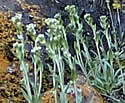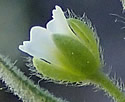Draba cana (Hoary Whitlow-grass)
| Also known as: | Hoary Draba |
|---|---|
| Genus: | Draba |
| Family: | Brassicaceae (Mustard) |
| Life cycle: | perennial |
| Origin: | native |
| Status: |
|
| Habitat: | part shade, shade, sun; crevices and ledges on cool, north-facing cliffs, rock outcrops, alpine meadows |
| Bloom season: | May - July |
| Plant height: | 4 to 12 inches |
| Wetland Indicator Status: | none |
| MN county distribution (click map to enlarge): |  |
| National distribution (click map to enlarge): |  |
Pick an image for a larger view. See the glossary for icon descriptions.
Detailed Information
Flower: 


![[photo of flowers]](/udata/r9ndp23q/pd/draba-cana 527436-32-t.jpg) Tight cluster of stalked flowers at the tip of the stem, arising from upper leaf axils, and the ends of the occasional branching stem in the upper plant. Flowers are 1/8 to ¼ inch across with 4 spreading, white petals rounded or slightly notched at the tip, and 6 yellow stamens in the center. Buds are yellowish green. The sepals behind the flower are egg-shaped to oblong and covered in long, spreading and star-shaped hairs. The flowering stems elongate as the plant matures, with fruit forming below and flowers just opened at the tip of the stem
Tight cluster of stalked flowers at the tip of the stem, arising from upper leaf axils, and the ends of the occasional branching stem in the upper plant. Flowers are 1/8 to ¼ inch across with 4 spreading, white petals rounded or slightly notched at the tip, and 6 yellow stamens in the center. Buds are yellowish green. The sepals behind the flower are egg-shaped to oblong and covered in long, spreading and star-shaped hairs. The flowering stems elongate as the plant matures, with fruit forming below and flowers just opened at the tip of the stem
Leaves and stems: 


![[photo of basal leaves]](/udata/r9ndp23q/pd/draba-cana-7983-t.jpg) Leaves are just over 1 inch long, stalkless, the basal leaves in a dense rosette, linear-oblong to spatula-shaped. Stem leaves are widely spaced, becoming smaller as they ascend the stem, and mostly lance-oblong. Leaf edges may be toothless or have a few irregular teeth, mostly on the upper half
Leaves are just over 1 inch long, stalkless, the basal leaves in a dense rosette, linear-oblong to spatula-shaped. Stem leaves are widely spaced, becoming smaller as they ascend the stem, and mostly lance-oblong. Leaf edges may be toothless or have a few irregular teeth, mostly on the upper half
![[photo of stem and stem leaves]](/udata/r9ndp23q/pd/draba-cana-527436-19-t.jpg) Leaf surfaces are densely covered in star-shaped hairs. Stems are single or multiple from the base, mostly simple but may be branched in the upper plant, and are densely covered in a mix of short, star-shaped hairs and long, spreading hairs.
Leaf surfaces are densely covered in star-shaped hairs. Stems are single or multiple from the base, mostly simple but may be branched in the upper plant, and are densely covered in a mix of short, star-shaped hairs and long, spreading hairs.
Fruit: 
![[photo of fruit]](/udata/r9ndp23q/white/draba-cana-hoary-whitlow-grass_0715_160552-t.jpg) Fruit is a small, flattened, lance elliptic to oblong pod, wider at the base than at the tip, ¼ to ½ inch long and less than 1/10 inch wide, densely covered with short, star-shaped hairs, and often twisted.
Fruit is a small, flattened, lance elliptic to oblong pod, wider at the base than at the tip, ¼ to ½ inch long and less than 1/10 inch wide, densely covered with short, star-shaped hairs, and often twisted.
Notes:
Draba cana is considered a glacial relic, left-over from the last ice age. While common in the higher elevations of the Rockies, it is rare throughout the northeastern US where it clings to cold northern rocky cliffs. First discovered in Minnesota in 2001, it has been documented only three times, from high north facing cliffs in Lake county in the BWCA along the Canadian border, and one population on an island in Lake Superior in Cook county. In 2013 it was elevated to the status of State Endangered and is similarly rare in Wisconsin and Michigan. The dense covering of star-shaped hairs distinguish this from other members of the mustard family in Minnesota that have small, white flowers. At various times, the name Draba cana has been treated as a synonym of Draba lanceolata, or as a variety of D. breweri, var. cana. The latter is under debate in some circles but the former is generally considered an incorrect application, with D. lanceolata accepted as a distinct Eurasian species.
Native Plant Nurseries, Restoration and Landscaping Services ↓
More photos
 Hoary Whitlow-grass plant
Hoary Whitlow-grass plant Hoary Whitlow-grass plants
Hoary Whitlow-grass plants late season plant
late season plant Hoary Whitlow-grass habitat
Hoary Whitlow-grass habitat toothless basal leaves
toothless basal leaves toothed basal leaves
toothed basal leaves close-up of stem hairs
close-up of stem hairs more flowers
more flowers
Photos by K. Chayka and Peter M. Dziuk taken in Cook County.
Comments
Have you seen this plant in Minnesota, or have any other comments about it?
on: 2021-06-01 19:31:57
Saw this on May 30, 2021 on a north wall rock cliff, as you describe, on south arm of Knife Lake in BWCA. I'd be happy to send a picture to verify. I only took one because it was a high reach from the canoe.






